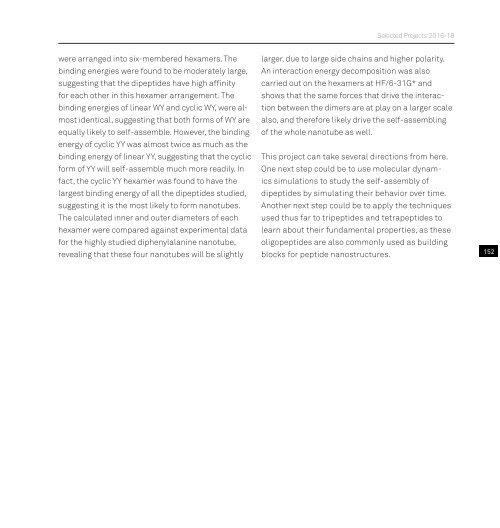Undergrad_Book_16-18_Pge_View_Print_no print marks_compressed
You also want an ePaper? Increase the reach of your titles
YUMPU automatically turns print PDFs into web optimized ePapers that Google loves.
Selected Projects 20<strong>16</strong>-<strong>18</strong><br />
were arranged into six-membered hexamers. The<br />
binding energies were found to be moderately large,<br />
suggesting that the dipeptides have high affinity<br />
for each other in this hexamer arrangement. The<br />
binding energies of linear WY and cyclic WY, were almost<br />
identical, suggesting that both forms of WY are<br />
equally likely to self-assemble. However, the binding<br />
energy of cyclic YY was almost twice as much as the<br />
binding energy of linear YY, suggesting that the cyclic<br />
form of YY will self-assemble much more readily. In<br />
fact, the cyclic YY hexamer was found to have the<br />
largest binding energy of all the dipeptides studied,<br />
suggesting it is the most likely to form na<strong>no</strong>tubes.<br />
The calculated inner and outer diameters of each<br />
hexamer were compared against experimental data<br />
for the highly studied diphenylalanine na<strong>no</strong>tube,<br />
revealing that these four na<strong>no</strong>tubes will be slightly<br />
larger, due to large side chains and higher polarity.<br />
An interaction energy decomposition was also<br />
carried out on the hexamers at HF/6-31G* and<br />
shows that the same forces that drive the interaction<br />
between the dimers are at play on a larger scale<br />
also, and therefore likely drive the self-assembling<br />
of the whole na<strong>no</strong>tube as well.<br />
This project can take several directions from here.<br />
One next step could be to use molecular dynamics<br />
simulations to study the self-assembly of<br />
dipeptides by simulating their behavior over time.<br />
A<strong>no</strong>ther next step could be to apply the techniques<br />
used thus far to tripeptides and tetrapeptides to<br />
learn about their fundamental properties, as these<br />
oligopeptides are also commonly used as building<br />
blocks for peptide na<strong>no</strong>structures.<br />
152



